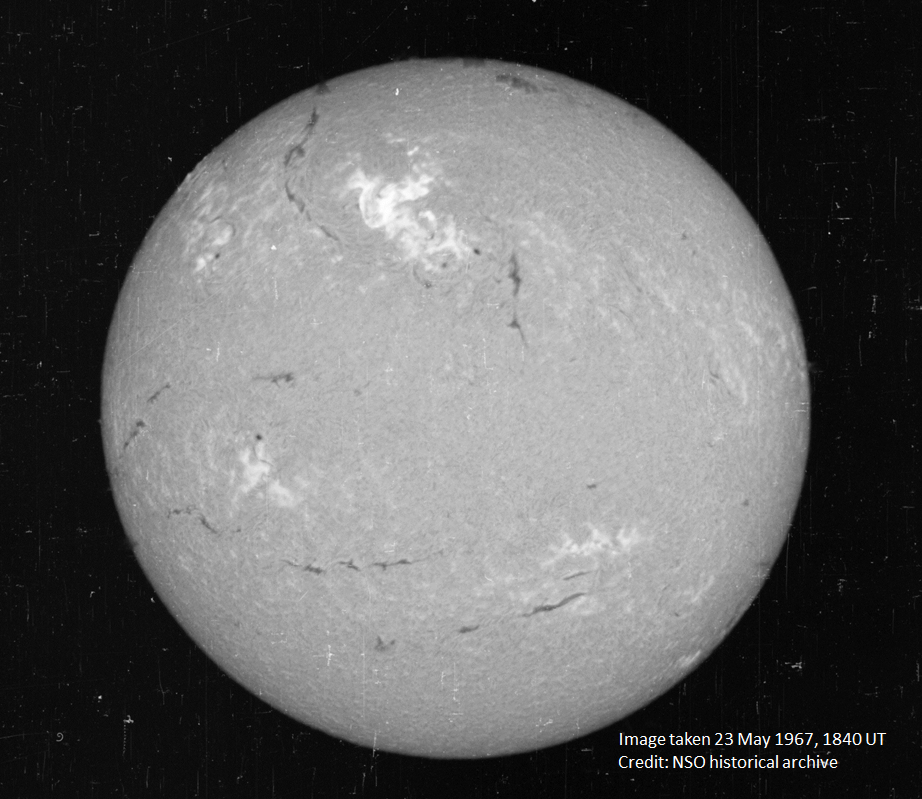1967 solar storm nearly took U.S. to brink of war
Study credits space weather forecasters with helping avoid a nuclear conflict
Aug 9, 2016 - by Staff
Aug 9, 2016 - by Staff
Delores Knipp, a senior research associate at NCAR's High Altitude Observatory, is the lead author of a new paper published in the journal Space Weather. Knipp is also a research professor at the University of Colorado Boulder, a UCAR member institution. This is an excerpt from a news release by the American Geophysical Union.
Aug. 9, 2016 | A solar storm that jammed radar and radio communications at the height of the Cold War could have led to a disastrous military conflict if not for the U.S. Air Force’s budding efforts to monitor the sun’s activity, a new study finds.
 A view of the Sun on May 23, 1967, in a narrow visible wavelength of light called Hydrogen-alpha. The bright region in the top center region shows the area where the large flare occurred. Click to enlarge.
A view of the Sun on May 23, 1967, in a narrow visible wavelength of light called Hydrogen-alpha. The bright region in the top center region shows the area where the large flare occurred. Click to enlarge.
(Image courtesy of the National Solar Observatory historical archive.)
On May 23, 1967, the Air Force prepared aircraft for war, thinking the nation’s surveillance radars in polar regions were being jammed by the Soviet Union. Just in time, military space weather forecasters conveyed information about the solar storm’s potential to disrupt radar and radio communications. The planes remained on the ground and the U.S. avoided a potential nuclear weapon exchange with the Soviet Union, according to the new research.
Retired U.S. Air Force officers involved in forecasting and analyzing the storm collectively describe the event publicly for the first time in a new paper accepted for publication in Space Weather, a journal of the American Geophysical Union.
The storm’s potential impact on society was largely unknown until these individuals came together to share their stories, said Delores Knipp, a space physicist at the University of Colorado in Boulder, a senior research associate at the National Center for Atmospheric Research, and lead author of the new study. Knipp will give a presentation about the event on August 10, 2016 at NCAR's High Altitude Observatory in Boulder, Colorado.
Hear Delores Knipp discuss the new paper during a live webcast on Wednesday, Aug. 10, at 3 p.m. Mountain Time.
The storm is a classic example of how geoscience and space research are essential to U.S. national security, she said.
“Had it not been for the fact that we had invested very early on in solar and geomagnetic storm observations and forecasting, the impact [of the storm] likely would have been much greater,” Knipp said. “This was a lesson learned in how important it is to be prepared.”
Read the full release at AGU.
Title: The May 1967 Great Storm and Radio Disruption Event: Extreme Space Weather and Extraordinary Responses
Authors: D. J. Knipp, A. C. Ramsay, E. D. Beard, A. L. Boright, W. B. Cade, I. M. Hewins, R. McFadden, W. F. Denig, L. M. Kilcommons , M. A. Shea, and D. F. Smart
Journal: Space Weather, DOI: 10.1002/2016SW001423